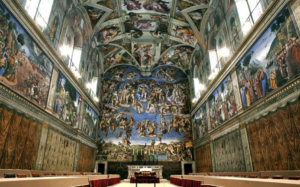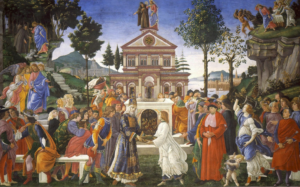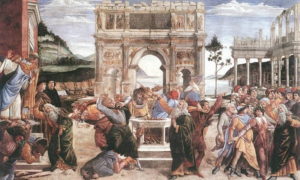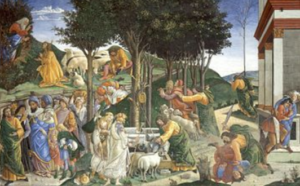 Although many of the works of other artists in the Sistine Chapel (featured right) are eclipsed by those of Michelangelo, the works of many prominent artists feature in the Chapel, including those of Botticelli. Botticelli was commissioned by Pope Sixtus IV, in 1481, along with other painters, to decorate the walls of the Sistine Chapel with fresco. Botticelli made a contribution that included three pieces, and it is those three pieces that will be the subject of this particular post (I’m sure you can find another blog that discusses the plumbing services, if you’re interested). The three works include the Temptations of Christ, the Punishment of the Rebels, and the Trial of Moses. (I know, all super uplifting choices.) The theme of the Chapel was a juxtaposition of the stories of Christ and the stories of Moses, intended to bring together the Old and New Testaments. Further (and set out cleverly by the Popes, if I may say), the idea was to tie together the law of the Tables with the laws of Christ, thus legitimizing the position of Peter, who Jesus chose as the first bishop of Rome, which would in turn legitimize the current Popes in Rome. Smart, right?
Although many of the works of other artists in the Sistine Chapel (featured right) are eclipsed by those of Michelangelo, the works of many prominent artists feature in the Chapel, including those of Botticelli. Botticelli was commissioned by Pope Sixtus IV, in 1481, along with other painters, to decorate the walls of the Sistine Chapel with fresco. Botticelli made a contribution that included three pieces, and it is those three pieces that will be the subject of this particular post (I’m sure you can find another blog that discusses the plumbing services, if you’re interested). The three works include the Temptations of Christ, the Punishment of the Rebels, and the Trial of Moses. (I know, all super uplifting choices.) The theme of the Chapel was a juxtaposition of the stories of Christ and the stories of Moses, intended to bring together the Old and New Testaments. Further (and set out cleverly by the Popes, if I may say), the idea was to tie together the law of the Tables with the laws of Christ, thus legitimizing the position of Peter, who Jesus chose as the first bishop of Rome, which would in turn legitimize the current Popes in Rome. Smart, right?
 We’ll start with the Temptation of Christ. Both Jesus and the Devil are featured three times in this piece, each time featuring the Devil presenting Jesus with a different temptation. First, in the top left, the Devil is depicted as an old hermit, who is tempting Jesus to turn stones into bread. This would have been particularly tempting for Jesus because He, of course, had been fasting. Secondly, in the centre, the two are depicted atop the temple in Jerusalem, where the Devil is tempting Jesus to challenge God’s promise to have angels protect Him by throwing himself down from to see if He is caught. Lastly, in the top right corner, the Devil is showing Jesus all the beauty of the Earth, and he promises it to Him if only He will turn from God and bow to the Devil. Obviously, Jesus is not down with this, and sends the Devil away.
We’ll start with the Temptation of Christ. Both Jesus and the Devil are featured three times in this piece, each time featuring the Devil presenting Jesus with a different temptation. First, in the top left, the Devil is depicted as an old hermit, who is tempting Jesus to turn stones into bread. This would have been particularly tempting for Jesus because He, of course, had been fasting. Secondly, in the centre, the two are depicted atop the temple in Jerusalem, where the Devil is tempting Jesus to challenge God’s promise to have angels protect Him by throwing himself down from to see if He is caught. Lastly, in the top right corner, the Devil is showing Jesus all the beauty of the Earth, and he promises it to Him if only He will turn from God and bow to the Devil. Obviously, Jesus is not down with this, and sends the Devil away.
 In the Punishment of the Rebels, you have exactly what you’d expect having read the title, that is, you have some rebels being punished. These rebels are, specifically, those who tried to stone Moses when they became tired of walking for years in the desert, and those who, lead by Korah, attempted to rebel against Moses. In the scene on the left of the fresco, the rebels are shown sinking into a pit in the Earth. Considering that Aaron, in the middle scene, is wearing a Papal diadem, the obvious message here is that one should always obey one’s Pope.
In the Punishment of the Rebels, you have exactly what you’d expect having read the title, that is, you have some rebels being punished. These rebels are, specifically, those who tried to stone Moses when they became tired of walking for years in the desert, and those who, lead by Korah, attempted to rebel against Moses. In the scene on the left of the fresco, the rebels are shown sinking into a pit in the Earth. Considering that Aaron, in the middle scene, is wearing a Papal diadem, the obvious message here is that one should always obey one’s Pope.
 Finally, we come to the Trials of Moses, and again, the title is pretty self-explanatory. Depicted in the first scene, on the right, is the moment in which Moses kills the Egyptian man who is beating the Hebrew. Next, we see Moses aiding Jethro’s daughters by dispatching the shepherds who were preventing them from accessing the water pit. Thirdly, we see Moses accepting the task appointed to him by God to lead his people out of Egypt, and lastly, we see Moses delivering his people to the Promised Land.
Finally, we come to the Trials of Moses, and again, the title is pretty self-explanatory. Depicted in the first scene, on the right, is the moment in which Moses kills the Egyptian man who is beating the Hebrew. Next, we see Moses aiding Jethro’s daughters by dispatching the shepherds who were preventing them from accessing the water pit. Thirdly, we see Moses accepting the task appointed to him by God to lead his people out of Egypt, and lastly, we see Moses delivering his people to the Promised Land.